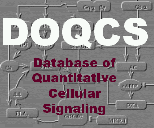| | Name | Initial Conc. (uM) | Volume (fL) | Buffered |
| 1 | IP1(1) | 0 | 1000 | No |
| | Inositol (1)monophsophate According to Gee et al (Biochem J 249; 1988: 888) Ins(1)P conc upto 44 uM. But this is mainly from phosphotidylinositol lipid metabolism that we have not considered. |
| 2 | IP1(3) | 0 | 1000 | No |
| | Inositol (3)monophsophate Conc equals 11% of Ins(1)P1 conc as per Ackerman et al, Biochem J 242(2); 1987: 517 |
| 3 | IP2(13) | 0 | 1000 | No |
| | Inositol (13)bisphosphate according to Batty et al (Biochem J 258(1); 1989: 23-32) Ins(13)P2 forms 22% of all InsP2 in cerebral cortex slices. Our simulations generate similar basal levels |
| 4 | IP2(34) | 0 | 1000 | No |
| | Inositol (34)bisphosphate |
| 5 | IP2_3pase1 | 0.0038 | 1000 | No |
| | from Caldwell et al, JBC 266(27); 1991: 18378-86 Enzyme is a homodimer with two catalytic subunits. Conc of enzyme increased 2 times from 1.9 nM to account for two monomeric subunit pools |
| 6 | IP2_3pase2 | 0.0094 | 1000 | No |
| | from Caldwell et al, JBC 266(27); 1991: 18378-86 enzyme is a heterodimer with one catalystic subunit and one regulatory 78 kDa subunit |
| 7 | IP3(134) | 0 | 1000 | No |
| | Inositol (134)trisphosphate |
| 8 | IP_4pase | 0.9 | 1000 | No |
| | from Norris et al, JBC 269(12); 1994: 8716-20 Enzyme conc increased from 9 nM to 0.9 uM to obtain appreciable enzyme activity has two 4-phosphatase activities: against Ins(134)P3 and Ins(34)P2 respectively |
| 9 | IP_4pase_inact | 0 | 1000 | No |
| | |
